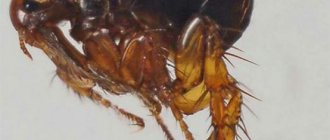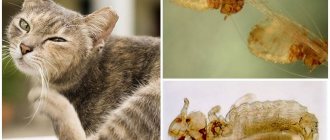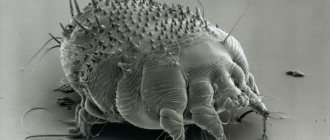Hypersensitivity to flea bites
Flea dermatitis is an allergic disease caused by flea bites. Proteins contained in insect saliva cause immediate or delayed consequences in the form of itchy irritation, scabs, and later bleeding scratches and wounds.
Many pets are susceptible to this disease, since the proteins in flea saliva are a very strong allergen. Flea scratches more often appear in cats that are free-range or live on the street, but domestic cats are not immune from them: fleas can be brought into the house on clothes or shoes.
Allergy to bites
Symptoms of the disease
Allergy to flea bites in cats
A caring owner can understand that a cat is allergic to fleas (allergic dermatitis) by the following signs:
- severe itching – the pet itches very often and also tries to bite its fur and skin;
- breathing problems - possible coughing, wheezing when inhaling and exhaling;
- liquid discharge from the nose and eyes;
- hair loss, the consequence of which may even be baldness of some parts of the animal’s body;
- the presence of papules - small red bumps on the surface of the skin;
- redness of the skin, scratches and wounds.
Most often, such symptoms can be observed in cats in the groin or in an area located closer to the base of the tail. In more rare cases, parasites become active on the pet's face and neck, and fleas almost never attack a cat's paws.
The above symptoms can be observed for several days. Secondary infection is especially dangerous. It occurs due to the fact that the cat actively scratches its skin until wounds form. They are the source of infection by pathogenic fungi and bacteria.
Types of flea dermatitis
Flea dermatitis is one of the most common feline skin diseases. Appears in the following varieties:
- spicy;
- subacute;
- chronic.
In acute dermatitis, the symptoms are pronounced, and the disease develops very quickly.
The chronic form is characterized by the appearance of areas of baldness and the appearance of small itchy nodules on the skin. Develops in the absence of proper treatment.
The subacute stage is a transitional stage. A characteristic symptom is a rapid onset, the onset of visible relief and subsequent exacerbation. This is a sign that the therapy was chosen incorrectly.
The main danger is complications arising from flea dermatitis. Atopic eczema may develop, which cannot be completely cured. There is also a risk of secondary purulent infections requiring antibacterial treatment.
Symptoms
The severity of symptoms depends on many factors: the age of the cat, its weight, the number of parasites and the general state of the immune system.
The first, most pronounced symptom is itching. The cat has very itchy wounds caused by scratching flea bites.
After some time, the hair begins to fall out, bald spots appear, the hairline becomes thinner, and ulcers appear on the skin.
The next stage is the appearance of scabs and crusts. The animal regularly scratches them, this causes suppuration, which indicates the addition of a bacterial infection.
The general condition of the cat worsens: weakness, lack of appetite appears, the animals meow loudly from itching and pain, and become very timid.
Allergy symptoms and how to recognize them
So what symptoms can you use to distinguish your pet’s allergies from other diseases? There are a number of characteristic signs of allergies. But there is also a problem that it is impossible to determine from them what caused this condition.
To solve this problem, you need to contact a veterinary hospital, where specialists can conduct laboratory tests to determine the cause of this reaction. But what symptoms, after all, are determining in making a diagnosis of allergy?
At first it can be local, and then spread to large areas of the body. The rash can develop into allergic dermatitis, which indicates the addition of a bacterial infection.
The next symptom is itching. Cats itch mainly in the area of the root of the tail, back and ears. Itching is a consequence of the release of biologically active substances in response to an allergen that has entered the body. Constant itching can lead to damage to the skin and secondary infection.
Skin redness
Redness of the skin in the ear area and the ears themselves is also one of the symptoms of allergies.
The animal may try to scratch them, which can lead to skin lesions and otogemetomas - accumulations of blood under the skin of the auricle. Constant itching and inflammation of the skin can lead to bald patches on the skin and severe hair loss, which can also indicate an allergy in your pet.
In very furry animals, it is difficult to notice such a symptom as redness of the skin. On the contrary, in hairless cats, such as Sphynxes and Bambinos, these manifestations are always very noticeable, and these breeds themselves are highly allergic. Some time after the appearance of redness, peeling skin and dandruff may occur.
And it is also worth paying attention to discharge from the eyes and nose, which may be another indication of problems in the animal
Diarrhea, vomiting, snoring
Diarrhea and vomiting are common and characteristic signs of allergic reactions of a food nature. Snoring can also indicate an allergy. This phenomenon is explained by swelling of the nasal mucosa and difficulty in the passage of air through the nose during sleep.
Although these are not all the signs of allergies in cats, if you notice even one of them, you should immediately consult a veterinarian, without waiting for all of them to appear.
Diagnostics
The simplest diagnostic method before going to the vet is using a comb and a piece of paper.
First, the cat's fur needs to be well wetted. After this, the animal is placed on white paper and begins to be combed. A characteristic sign of flea infestation is the appearance of brown droplets on the paper. This color is the color of flea secretions. With extensive damage, living insects can also be seen.
To notice the presence of sores on the skin, you will need to part the fur and examine it with a magnifying glass. You may see brown spots, redness, and flea scratches.
A visit to the veterinarian is required: the doctor will conduct laboratory tests, perform scrapings and blood tests. This will help establish an accurate diagnosis based on the presence of antibodies.
A special allergy test may be required to identify the type of protein to which the animal’s body reacts.
Ways of occurrence of fleas and symptoms
Fleas in cats are parasites that are most often found in the summer in animals that go outside. Their appearance in the fur requires an immediate reaction from the owner aimed at destruction. Such parasites are carriers of various diseases and pose a threat not only to cats, but also dangerous to humans, because they can also bite people.
If insects multiply heavily in your pet's fur, diseases such as anemia, weakened general immunity, and others are possible. As a result, every owner should know what fleas look like on cats, where they come from and the signs of parasites in a pet, and then think about how to get rid of them.
Ways of parasites appearing in domestic animals:
- accidental introduction of flea eggs or larvae from the street or from the entrance; according to statistics, 95% of these insects live in the basements of apartment buildings;
- from a neighboring apartment where there are infected pets;
- after contact with yard or wild dogs and cats.
Signs of the presence of fleas
In modern cities, there are a large number of homeless animals, and the presence of unsanitary conditions contributes to the reproduction and comfortable existence of various types of parasites that migrate and infect pets.
On a note!
Fleas often carry worm eggs, so after eliminating ectoparasites from a pet, it should be additionally treated with anthelmintic drugs.
Symptoms indicating the presence of fleas in a cat:
- the animal behaves restlessly, actively itches, tries to bite off parasites and licks itself;
- some cats become nervous due to constant itching;
- Living adult insects can be found among the undercoat;
- red dots appear on the skin at the sites of bites; if an infection occurs, they become inflamed and can develop into wounds, possibly causing dematitis;
- black dots are visible among the fur - flea excrement;
- Pests can be found in places where a cat cannot reach them: near the ears, in the armpits, on the back, chest and neck.
If you suspect that cats have fleas, you should carefully examine the fur for the presence of black spots of digested blood. Flea feces, when rubbed with your fingers, are separated into small particles that are clearly visible among the hairs. If the undercoat is short, the animal combs it onto the floor, where it can become food for the larvae.
Treating scratches at home
Self-medication for flea dermatitis is unacceptable, but primary therapy can be started at home.
the washing up
The animal is washed and treated with flea control. Fleas and their larvae are combed out with a fine comb. For prevention, after treatment, a special anti-parasitic collar is worn.
If there are bleeding wounds on the skin, they can be treated along the edges with iodine and tetracycline ointment. If there is pus, an antibiotic is needed - you cannot select it yourself - only on the recommendation of a doctor.
Important! To protect the animal from poisoning, all products must be thoroughly washed out of the fur. To avoid licking, you can use a special collar.
Antiallergic therapy
If a cat is allergic to fleas, it must be treated, as over time the consequences of the disease can only get worse.
- If there are signs of allergy, the animal must be given an antihistamine, the dosage of which is determined by the veterinarian. Such a medicine is suprastin or diphenhydramine.
- Hydrocortisone ointment will help relieve your cat's itching. However, if there is damage to the skin, its use is contraindicated.
- To heal wounds resulting from scratching, chloramphenicol ointment is used. The drug prevents the further spread of the inflammatory process. A cream containing aluminum has a good healing effect. This is Aluminum or Alusprey. When treating a cat, it is important to prevent it from licking the medicine from its fur, as this can lead to poisoning. To alleviate the situation, a special tube collar will help, which is placed around the cat’s neck and deprives it of the opportunity to lick itself.
- In particularly difficult cases, a specialist may prescribe hormonal injections that block allergic symptoms and provide immediate relief. Sublingual drops containing flea antigens may also be prescribed. They form a healthy immune response to flea bites.
- If secondary infections are present, a course of antifungal drugs or antibiotics is necessary.
To ensure that cats are never allergic to flea bites, it is necessary to regularly inspect your pet’s fur and, if necessary, use anti-flea products. After all, preventing a disease is much easier than treating it.
Treatment
Your veterinarian will prescribe medications to treat flea dermatitis. The treatment regimen is as follows:
- relieving acute itching using antihistamines based on glucocorticosteroids;
- antiparasitic treatment, including the destruction of fleas and the use of preventive agents;
- treatment of secondary purulent infection with antibacterial agents.
The main requirement for treating cats is regularity. You should not take breaks in the use of antiparasitic drugs, as this may cause the disease to become chronic. When using antibiotics, it is unacceptable to complete the course before the time specified by the veterinarian in order to avoid the development of drug resistance.
Prevention of flea dermatitis
An effective means of preventing flea dermatitis is regular treatment of the animal with antiparasitic drugs or the use of flea collars. They should be used regardless of whether the cat goes outside, since flea larvae are carried indoors with the owners' shoes.
Regarding the diagnosis and treatment of flea dermatitis in cats in our clinic, you can contact veterinarians - dermatologists Oksana Anatolyevna Maykova, Ekaterina Sergeevna Novik
Use of anti-flea products
Flea medications are a mandatory stage of treatment. They are available in the form of external agents (drops, sprays and ointments). When using them, you should not wash the animal frequently, as this reduces the effectiveness of the medicine.
Another form of release is tablets. Chewable pills are well absorbed by cats and have a quick effect, being absorbed into the blood and destroying parasites. For preventive purposes they are used once a month.
Your doctor should advise you on how to treat your cat's scratching. You should not prescribe the drug and dosage yourself.
Treatment with folk remedies
When choosing how to treat a cat’s sores, you can turn to auxiliary folk methods. They can provide an additional effect, but cannot 100% replace drug therapy.
The following alternative medicines have proven themselves well:
- wormwood oil (repels fleas due to its pungent odor);
- turpentine solution (in a dosage of 50 ml per 10 liters of water);
- a mixture of garlic and brewer's yeast (for treating beds, carpets and upholstered furniture where the animal sleeps).
Wormwood oil
If your cat scratches the bites a lot, you can use a weak chamomile decoction to wash it - it soothes sensitive skin.
Before using any methods, you should consult your veterinarian.
Flea reproduction
A female flea can lay up to 10 eggs per day, which she shoots in her fur onto the skin without attaching them to anything. They are very small, about 0.5 mm, white, visually similar to semolina groats. You can see what flea eggs look like in cats in the photo below.
Reproduction of fleas and their eggs
The eggs easily slide off the fur, onto the floor or into the grass outside when walking. The flea larvae in cats that hatch after 14 days look like small dark worms that lack legs and eyes. The size of the larvae can reach 6 mm with a thickness of about 1 mm. They feed on organic waste or blood particles from flea feces.
Habitats for flea larvae: dust on the floor, carpets and furniture, various fleecy fabrics, ceiling cracks. Therefore, regular cleaning of the house with a vacuum cleaner will help greatly reduce the number of larvae and fleas in the apartment.
Prevention of dermatitis in cats
To prevent recurrence of the disease, appropriate precautions must be taken.
- It is better not to let the animal roam freely, and if it is not possible to keep it at home at all times, use an anti-flea collar.
- Contact with other animals is limited.
- It is recommended to take off your shoes when outside the home and wash the soles of your shoes with hot water and soap to avoid bringing in flea larvae.
- After contact with street animals, hands should be treated with an antiseptic or washed thoroughly.
Prevention of feline dermatitis
Fleas wait for your pet on the street and even at home. A person, without realizing it, brings flea larvae into the house on shoes. They hatch and strive to find a new owner - your pet. To prevent this from happening, it is worth taking some preventive measures:
- Do not let your pet outside.
- Limit the animal's contact with other cats and dogs.
- Get all your pets treated for worms and fleas every six months.
- Put your cat on a flea and tick collar. Even if the pet does not walk outside.
- Take off your shoes outside the home. If this is not possible, immediately wash the soles of your shoes in hot water and soap.
- If you touched your neighbor's kitten, wash your hands thoroughly when you get home. Flea larvae remain on them, which will quickly spread to your cat’s body.
In order to prevent the development of flea allergies in cats, as well as dermatitis and other complications, the pet owner performs the following actions:
- does not let the cat outside if it has a flea allergy;
- Do not walk your pet in places where there is high air humidity. After all, it is in such areas that fleas live for a very long time;
- treats cat fur with specific anti-flea drugs once every 1 month. Moreover, such products cannot be used if they have already expired;
- puts a flea collar or a special flea collar on the pet;
- regularly examines the pet - checks for the presence of various types of fleas on the cat;
- more often treats the entire space in the corridor near the front door with specific long-acting products;
- carries out wet, thorough cleaning and treats carpets with insecticidal agents against fleas;
- If allergic feline dermatitis develops, take your pet to an appointment with the attending veterinarian.
If the pet's condition does not improve, then it should be immediately shown to the attending physician. In such a situation, the veterinarian takes a skin scraping from the infected animal and prescribes the necessary anti-flea medication from it.
Moreover, pet owners should not use anti-flea medications on their own without first visiting a veterinarian. After all, some of them lead to possible side effects.
If you find an error, please highlight a piece of text and press Ctrl Enter. We will definitely fix it, and you will suffer karma











